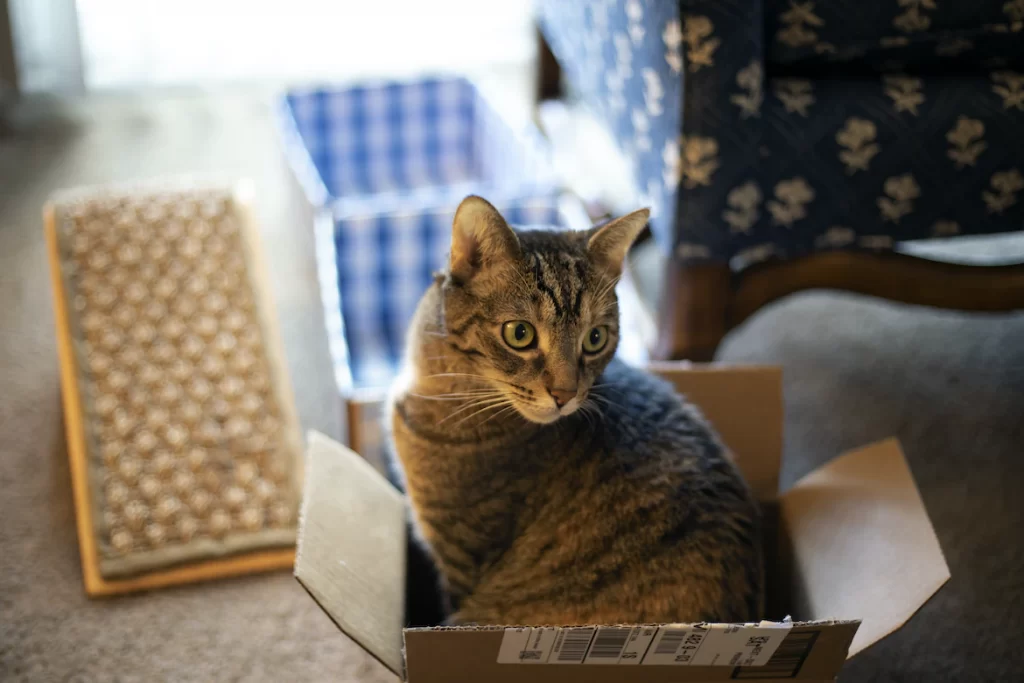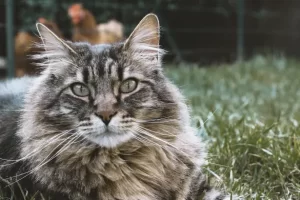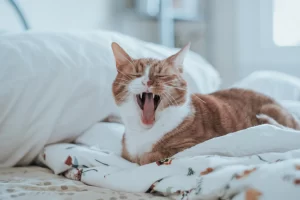Last updated on February 4th, 2023 at 03:05 am

If you own a cat, you must be wondering if a cat should eat bread or not. Other cat powers must have seen their cats take a slice of bread. If you spend some time around cats, you may notice their little appetite that occurs from time to time. The cat can enjoy the best-wet cat food one minute, then the next they are taking something else, which has a high chance of being unhealthy, like bananas, cheese, and cantaloupe. What happens when your cat develops an interest in eating bread?
In general, bread does not cause any harm to your cat. However, it would help if you fed your cat with bread on rare occasions. Avoid giving bread to your cat daily. Let it be a mouthful if you need to provide the cat with bread. When you feed your cat foods with high carbohydrate levels, like bread, your cat has a high chance of gaining weight and developing chronic health issues. Through the article, we shall look at the amount of bread a cat can take, how safe bread is for cats, and more information about feeding your cat with bread.
What are the nutrition statistics of bread?
Several types of bread exist, thus making it difficult to include the bread’s statistics. For instance, ‘regular’ bread can be made with milk, eggs, oil or butter, and other vitamins. We reviewed 100g of bread and acquired the following information.
- Water: 35.7g
- Energy: 270kcal
- Protein: 9.43g
- Fat: 3.59g
- Carbohydrate: 49.2g
- Fiber: 2.3g
- Sugars: 5.34g
- Bread made for commercial purposes mainly has added vitamins and minerals. It includes
- Thiamin: 0.5mg
- Niacin: 4.4mg
- Folate: 111ug
- Selenium: 23.2ug
- Calcium: 211mg
- Sodium: 477mg
The bread offers different nutritional benefits, depending on the type of bread. However, bread does not have any nutritional benefits for your cat. In addition, cats do not require high levels of carbohydrates for their daily life development and activities.
Should cats eat bread?
Bread does not cause any harm to your cat. However, feeding your cat some bread is not advisable. Bread has no or slight nutrition advantage to cats as it contains high amounts of carbohydrates that are good for humans. When cats consume bread, they acquire numerous empty calories.
When cats take a slice of bread, they acquire almost 1/5 of the recommended calorie intake. Therefore, when your cat takes more bread, it leaves little room for nutritionally balanced cat food. Nevertheless, a small piece will not cause significant harm if your cat is interested in taking bread.
Note that not every type of bread is suitable for cats’ intake. For instance, pricey artisanal bread is hazardous when taken by a cat. Before feeding your cat bread, please confirm that it contains cat-safe components. Bread that contains flavors and garnishes is harmful; therefore, if the bread has fruit, herbs, garlic, or spices, avoid feeding it to your cat.
Avoid feeding your cat with bread that has substances placed on it. PBJ contains high fat levels and calories acquired from butter and peanut butter, sugar, and fruit in jelly, which is harmful to cats. Pina au chocolate is a great breakfast for you. However, chocolate contains Theo bromine, caffeine unsafe for cat consumption, and other substances that can lead to health complications.
If your cat feeds on some bread without your attention, here are some symptoms to watch out for
- Diarrhea
- Weakness
- Vomiting
- Lethargy
- Drooling]
- Higher heart rates
- Seizures
- Loss of appetite
- Lack of coordination
- Depression
- Hyperactivity
- Tremors
- Increased thirst
- Pale gums
- Breathing difficulties
In general, plain baked bread is safe for your cat. Nevertheless, avoid feeding the cat with raw dough as it develops in your cat’s stomach leading to bloat and, if severe, can be fatal. In addition, yeast in the dough produces carbon dioxide and ethanol after consumption. If your cat takes raw dough, consult the veterinarian immediately.
Why should cats not eat grain?
Most cats have food allergies. Among the leading cause of allergies in cats, grains are among the primary sources. Since cats are carnivorous, they lack the enzymes necessary for plant-based products like grains. With this knowledge, it is clear that feeding your cat food containing grain is terrible and can translate to serious health issues in cats. When a cat consumes grains or other allergies, it might vomit and have diarrhea, which translates to dehydration when not treated.
Which is the right way of feeding bread to your cat?
Only introduce bread into the diet if your cat is interested in bread. Feed the cat with excellent cat treats for cat consumption. Nevertheless, if you notice that your cat has developed a bread craving anytime you are taking a sandwich or breakfast, offer a small piece that will not cause significant harm.
Use small pieces of plain baked bread to feed your cat to eliminate the bread cravings. If you need to give your cat some pills or oral medication, cats that love bread will be easy. Fold the tablet on the piece of bread. This is an excellent way of tricking the cat into taking pills, maybe for some time before they notice the trick.
What types of bread are bad for your cat?
A few types of bread should not be fed to your cat, even though they lack dangerous components. The bread includes,
- Rising dough.
Avoid feeding your cat raw bread dough. The basic dough contains active yeast that causes the bread to rise. When the cat consumes the yeast, the rising occurs in its stomach. The action can lead to significant complications like bloating and digestive obstruction. Yeast yields ethanol as a byproduct of fermentation. Therefore, once the cat consumes dough, it ferments, and the ethanol produced leads to illness since cats are less tolerant to alcohol than humans.
Yeast further leads to the neurological system, resulting in organ failure and death. Carbon dioxide in the stomach makes it dilate and swell up, leading to gastric dilation-volvulus, a condition that can lead to death.
- Bread containing xylitol
Xylitol is a sweetener present in baking products that cats should not consume. Cats consuming bread with xylitol cause a drastic drop in blood sugars, translating to liver failure or death.
- Nut bread.
You might be convinced that nut bread is great for cats as it contains fruit sweeteners and food flavors. Nut bread has high nut levels, and when taken regularly, it leads to weight gain and gastrointestinal disorders like vomiting and diarrhea.
Instead of feeding your cat nut bread, it is best to get them meat-flavored treats and tuna fish cans with a combination of their best-wet food.
- French toast.
Most people enjoy taking French toast, but it could be better for cat consumption. French toast has eggs, milk, and sugar which can be dangerous for cats. In addition, French toast has high carb levels that can lead to health issues when consumed excessively.
- Bread with raisins or garlic.
Raisins and garlic are dangerous foods that should not be fed to cats to prevent serious health issues that lead to death. Do not give your cat food that contains garlic or raisins. Avoid ingredients like chives, excess salt or butter, caramelized onions, and chocolate spreads.
Can a cat take banana bread?
It needs to be clarified whether cats should feed on banana bread. Banana bread ingredients include peanuts, peanut butter with xylitol, chocolate, and walnuts which are harmful to cats. However, walnuts are not dangerous to cats. Banana bread contains high sugar levels and unhealthy calories for the cat. Before the cat a banana bread, check the labels for ingredients.
Can cats eat bread crusts?
Yes. Bread crust does not cause complications to the cat when fed in small portions. However, apply the rules in the article. Ensure that the bread crust does not contain hazardous ingredients like garlic, onions, and chocolate.
Can a cat eat pumpkin bread?
You can feed the cat pumpkin bread depending on the ingredients present in the bread. Pumpkin bread contains raisins and walnuts. Walnuts are harmless but can lead to digestive distress in cats. Do not feed cats products that contain raisins since they are hazardous. Check out for ingredients before feeding your cat.
Why is my cat obsessed with bread?
As much as cats are carnivores, they have the senses to detect calories in food. However, it does not mean that feeding your cat bread is excellent. If your cat has acquired a bread obsession, it is best to take it for a checkup, as it can signify several health problems.
How much bread can a cat take?
The best amount of bread for cats is a small treat to help them take pills without struggles. If your cat takes a considerable amount of bread, it is best to contact the vet for advice. Do not feed a cat more than 10% of its calories bread limit. That amounts to 20 calories for a 9lb cat or ¼ slice. If you provide your cat with ¼ slice of bread, do not offer any other treat. Avoid feeding bread to cats with health issues like kidney diseases, heart conditions, and diabetes.
Conclusion
Most bread is not dangerous when fed to cats. However, avoid feeding your cat bread regularly. The leftover crust also contains a significant amount of calories. Bread has little or no nutritional gain to your cat; therefore, serve it in small pieces occasionally. The best option is to serve fruit and vegetables to offer the cat dietary benefits and a balanced diet.


